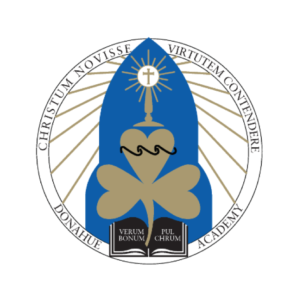How to Promote Eucharistic Devotion at Your School
Teaching young people about the Eucharist is important, but as Pope St. John Paul II warned in Catechesi Tradendae, the academic life can become too “intellectualized” without sacramental and Eucharistic devotion. Our students need to know of Christ’s Real Presence in the Mass, but then they need to love and adore Him.
At Donahue Academy, a parish K-12 school in Ave Maria, Fla., that I am honored to lead, we have taken several steps to promote Eucharistic devotion. Of course these are not the only ways of doing it, but they might suggest ideas for other Catholic educators.
1. Make devotion an explicit, visible part of the mission
Our School’s mission statement declares it to be a place “in which students encounter Christ and pursue excellence in all things. Our students will deepen their love of God and others through the pursuit of all that is true, good, and beautiful.”

We express that mission visibly in our school seal, which includes images of our parish church, a monstrance, a stylized Sacred Heart as part of a shamrock (our school’s team name), a book, and the words Christum novisse (encountering Christ). The seal serves as a story platform where we share how students will encounter Christ and pursue excellence through the sacraments (especially the Eucharist), their love for God and each other (the Sacred Heart), and their studies (the book).
While other schools will have unique articulations of their missions, all Catholic schools hold a common mission outlined by the Church. This mission is articulated in The Cardinal Newman Society’s Principles of Catholic Identity in Education:
1 | Inspired by Divine Mission
2 | Models Christian Communion and Identity
3 | Encounters Christ in Prayer, Scripture & Sacrament
4 | Integrally Forms the Human Person
5 | Imparts a Christian Understanding of the World
One can quickly see how devotion to the Eucharist hits all five principles. The Eucharist is the summation of everything we are trying to do as a Catholic school. If students get the Real Presence right, everything else naturally falls into place.
2. Make Mass a central, reverent, and frequent part of school life
Offering daily Mass creates a strong, vibrant Catholic culture. At Donahue Academy, we have a slightly longer school day (15-20 minutes based on grade level), and by offering Mass without a homily, our worship ends in 25 minutes. Mass is held in the gymnasium, and even that helps build community by having one grade set up in preparation for Mass and another grade tear down. The worship space is kept dark, with Gregorian Chant playing as students arrive. We kneel directly on the floor or in the bleachers, stressing the importance of reverence even when it seems a bit uncomfortable.
Daily Mass is required for grades K-8, but with parental permission, grades 9-12 can select Mass or a silent study hall that begins with reading the daily Gospel. Approximately 80 percent of our high school students voluntarily attend Mass. On Fridays, Mass attendance is required, and a short sermon is added along with beautiful, sacred music sung by a choir. We invest heavily in our choir and shower them with treats and awards as they serve multiple functions in our community. We heavily recruit and entice students to join the choir to ensure its elevated status.
In addressing the current loss of Eucharistic devotion in the Church, Father Peter Stravinskas has said, “Clear, unambiguous, orthodox teaching on the Holy Eucharist must be bolstered by unequivocal signs and symbols in the sacred liturgy. Students desperately need a sense of the sacred, of mystery, and of awe in God’s presence. To get students to encounter Christ in the Eucharist, we must do Liturgy and worship extremely well.”
In celebrating the Eucharist, we Catholic educators should be thoughtful, intentional, and spare no expense in time, effort, or accoutrement to fill this need. The challenge is real, and the response must be guided by the Spirit and the rich traditions of the Church, of which so many students and parents are unaware. Great things await students under such direction!
3. Make the Tabernacle accessible
We turned our most central and visible classroom space into a beautiful Eucharistic chapel, big enough for an entire class to visit. Every day our students walk by the chapel, prompting many to stop in for a visit. When the faculty “catch” the students praying or vice versa, powerful values are communicated and quietly strengthened. The ease and naturalness of a Eucharist encounter goes a long way!
4. First Friday Adoration
The U.S. bishops’ conference emphasizes that Exposition of the Blessed Sacrament flows from the sacrifice of the Mass and serves to deepen our hunger for communion with Christ and the rest of the Church.
For younger students, we start small with some singing and prayers, but we slowly help them grow in the ability to dwell peacefully in silence before the Lord. Each class takes time to adore Christ throughout the day, and we include the entire school in Benediction. The space is kept dark and prayerful with candles and lingering incense.
For the older students who may spend up to a full-class period in His Presence, we have Rosaries, Bibles, prayer books, and journals on hand. Also, at our first and last faculty meetings of the year and our Christmas celebration, the faculty gather for 30 minutes of Adoration and Benediction to pray for each other and their students.
5. Eucharistic processions
We offer a Eucharistic procession during Catholic schools week, with stations set up around the outside of the school. We find that having a Rosary procession in October prepares for the needed reverence and focus to achieve a school-wide Eucharistic procession in January. It is important to keep silent and focused and, when appropriate, kneel on the bare ground as a community in worship and humility. Again, the fruits of this are real and even spectacular!

